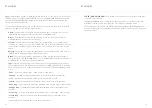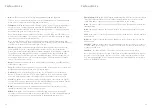
40
41
Sequencer
Gate Thru
- The same as ‘Gate’ but all MIDI notes are sent to the voices.
Great for re-harmonising a sequence - record chords into the sequence, then play it back
using a single finger to add a bassline.
Also useful for polyrhythms e.g. programming a 7-step sequence, then playing a 3 note
arpeggio alongside.
Tip: Try gate triggered animation sequences - mute or clear the note lane and play notes
to hear just the animation changes.
Gate Transpose
- The same as ‘Gate’ but the sequence is transposed relative to middle C
(note 60 / C4). Pressing note 60 repeatedly will play back the sequence as programmed,
playing note 61 will play the sequence back 1 semitone higher than programmed
Great when used in conjunction with the Arp + Arp octave controls, playing back some
sequence steps a few octaves above or below normal.
Sync Gate
- Sequencer timing driven from the sync in port (rising edge). Allows you to
drive the sequencer from external CV sources without affecting timing on the rest of
COBALT.
COBALT will not follow sync timing when this mode is enabled. To use sync as the clock
source for the whole synth, step sequencer will need to be in ‘Clock’ mode.
Sequencer LED’s will cycle in groups of 16 steps, with the first four blue sequencer LEDs
lighting to signify which group of 16 the sequencer is currently playing.
Summary of Contents for COBALT8X
Page 13: ...24 25 03 Synthesis engine...








































